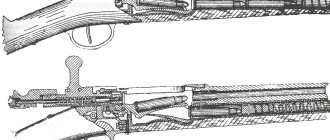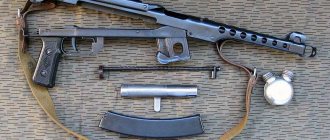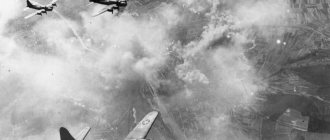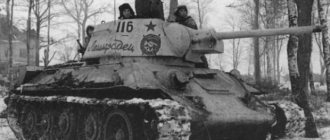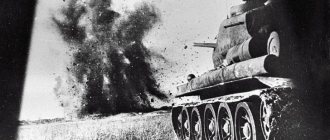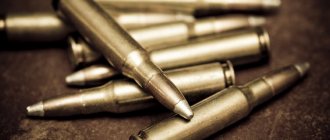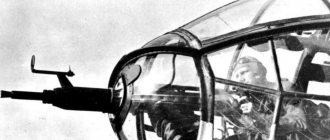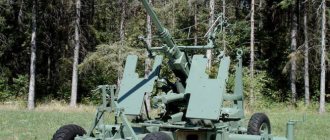De Lisle Commando Carbine
De Lisle Commando Carbine Prototype (model produced by Ford Dagenham)
The Second World War started extremely poorly for Great Britain. The rapid military operations of Nazi Germany in 1940 led to defeat on the continent and the evacuation of the remnants of the British Expeditionary Force.
As a result of this, for a long period of time, the only way of action in enemy territories for the British became special operations, during which reconnaissance was carried out and sabotage was carried out. The implementation of such operations became possible after, by personal order of British Prime Minister Winston Churchill, a special unit called “Commandos” was created.
The nature of the activities of such a specific unit required the use of special types of weapons, including low-noise ones. One such example was a compact carbine designed by William Godfray de Lisle.
Schemes of the De Lisle Commando Carbine from a patent issued to De Lisle
An Englishman of South African origin, William Godfrey De Lisle, who worked for the British Ministry of Aviation Industry in 1942, proactively developed and personally assembled a self-loading small-caliber carbine with an integrated silencer of his own design, based on the carbine FN Browning .22 Semi-automatic. This weapon interested Major Malcolm Campbell of the Combined Operations Headquarters (at that time the center of command for British special forces). Campbell came up with a proposal to test the new product, which was completed successfully.
Then De Lisle was offered to design a silent carbine chambered for the 9x19 Luger pistol cartridge for the British special forces. After testing a prototype chambered for a 9-mm cartridge, it was decided to use the .45 ACP (11.43×23 mm) pistol cartridge in the weapon, which has a subsonic bullet speed and greater stopping power.
De Lisle Commando Carbine by Sterling Engineering Co
In 1943, De Liesl successfully designed and personally assembled a prototype of his new silent carbine, using elements from three different production weapons. The design was a combination of a stock with a receiver and a redesigned bolt group of a standard Lee-Enfield SMLE No.1 rifle, a shortened barrel from a Thompson submachine gun and a modified magazine from a Colt M1911 pistol, as well as a silencer of the original design.
View of the controls of the De Lisle Commando Carbine
After minor modifications, this weapon was adopted by the British special forces with the designation “Commando Carbine”.
From a technical point of view, the silent De Lisle Commando Carbine was a short repeating rifle with manual reloading via a bolt action and an integrated shot silencer.
The bolt from the Lee-Enfield SMLE No.1 rifle was shortened (which was possible due to the rear location of the bolt lugs in the Lee-Enfield system), on which a new mirror was made, bored to fit the .45 ACP cartridge case, and was installed in the receiver new fixed ejector - reflector of the spent cartridge case.
View of the controls of the De Lisle Commando Carbine
The trigger mechanism and safety of the original Lee-Enfield rifle remained unchanged. The non-automatic safety lever is located on the left side of the receiver.
A .45 caliber barrel with 6 left-hand rifling, converted from the barrel of a Thompson submachine gun, was screwed into the receiver. The barrel in the front had several groups of holes to relieve pressure into the muffler of the De Liesle design.
The casing of the integrated muffler was attached to the front protrusion of the receiver using a thread (on prototypes it was made of steel, and on serial carbines - by aluminum alloy), the longitudinal axis of which was located below the axis of the weapon's barrel. The eccentric location of the silencer casing made it possible to “squeeze” the weapon into small dimensions and not unnecessarily raise its sights above the butt.
De Lisle Commando Carbine
Inside, the muffler was divided into two parts - the separator was located in the front, and the rear, surrounding the barrel, formed a single expansion chamber. The expansion of powder gases was carried out in several stages. A special coupling was screwed onto the muzzle of the barrel. Gases were vented from the barrel through four rows of holes made along the bottom of the rifling, first into the space between the barrel and the coupling, and from there into the rear chamber of the muffler. In front of the muzzle of the barrel, the coupling formed a bell, which contributed to the expansion of most of the gases, both ahead of the bullet and following it and not diverted through the holes in the walls of the barrel. These gases entered the separator, which was a series of split copper washers placed on two longitudinal rods and forming a series of chambers. The washer cuts were made at the top, and the edges of the cut were bent in different directions. This not only opened the way for the bullet, but also contributed to the “swirling” of gases, their inhibition and removal to the periphery of the chambers. The separator could be removed from the muffler for cleaning or replacement.
The weapon was fed with ammunition from a modified single-row detachable magazine from a Colt M1911 pistol with a capacity of 7 rounds. The modification of the pistol magazine consisted of soldering a vertical strip with a cutout for the standard Lee-Enfield SMLE rifle magazine latch to it on the rear wall. In addition to standard magazines with a capacity of 7 rounds, special extended magazines with a capacity of 11 rounds were also created.
For use in the carbine of pistol magazines, a new adapted magazine receiver made of sheet steel was installed. The magazine release is located inside the trigger guard, above the trigger.
Sight De Lisle Commando Carbine
The sighting devices of serial carbines consisted of a replaceable front sight on the muffler body and an adjustable sector rear sight from a Lanchester submachine gun. The front sight had protective “ears”, and the sight bar had notches from “1” to “6” in increments of 50 yards (46 meters).
The stock with a semi-pistol neck was “inherited” from the original Lee-Enfield rifle without changes. A small wooden forend was mounted under the muffler at its rear. Swivels were attached to the bottom of the butt and muffler.
In the “parachute landing” version of the “Airborne Model,” the carbine was equipped with a pistol grip and a metal butt folding down and forward. As a result, the sling swivels were moved to the left side of the weapon.
The first trial batch of prototypes of 17 carbines, for reasons of secrecy, was released at a motor vehicle in London under the personal supervision of De Lisle. Some of these samples were transferred to British special forces units and subjected to tests, which they successfully passed.
De Lisle Commando Carbine in the parachute version "Airborne Model"
After successful tests, a batch of 500 silent carbines was ordered in the summer of 1944, while 50 of the ordered carbines were to have a folding stock for use in special forces parachute units.
However, a total of about 130 silent De Liesl Commando carbines were produced, of which only two had a folding “landing” stock. In addition, Sterling made a number of changes to the design of the carbine, among which it is worth noting the replacement of the steel muffler casing with aluminum and the exclusion of the front casing bushing. Airborne Model Commando Carbine with folded stock
With the end of the Second World War, the contract for the production of the De Lisle Commando Carbine was canceled, since at that time work on equipping standard models of small arms with silencers was considered more promising in the UK.
During the Second World War, many different types of weapons appeared, which, although they were not produced in large quantities and did not participate in major battles, nevertheless left a noticeable mark on history. One of these samples was the silent De Lisle Commando carbine, which became the first mass-produced model of small arms with a multi-chamber integrated silencer. According to some experts, this carbine is one of the best examples of “silent” weapons from the Second World War, representing a very effective weapon for carrying out special operations behind enemy lines.
| Prototype | Commando Carbine | Airborne Model | |
| Caliber, mm | 11.43×23 (.45 ACP) | ||
| Length, mm | 945 | 922 | 897 / 653 |
| Barrel length, mm | 184 | ||
| Weight without cartridges, kg | 3.74 | 3.73 | 3.37 |
| Store, count. cartridges | 7 | 7; 11 | 7; 11 |
| Initial bullet speed, m/s | 253 | ||
| Sighting range, m | — | 274 | 274 |
The De Lisle design silencer could withstand up to 5,000 shots, completely eliminated muzzle flash, and the sound of a shot was difficult to distinguish on a quiet night at a range of 50 yards (46 meters), while the effective firing range of the carbine could reach 275 yards (251 meters). In terms of the degree of suppression of the sound of a shot, the accuracy of fire, and the damaging effect of a bullet, the De Lisle Commando carbine was superior to such well-known models of small arms for commandos as the “silent” model of the STEN Mk submachine gun. IIS and Mk VI.
For the first time, De Liesl Commando carbines were used in the Asian theater of operations, in Burma. Also, in addition to British special forces, this weapon was used by the American Special Operations Service and French resistance fighters in Europe in 1944-1945. After the end of World War II, a number of carbines were used in the 1950s during the Korean War of 1950-1953. and the Malaysian War of 1948-1960, and was also used by soldiers of the Special Air Service (SAS) during the conflict in Northern Ireland.
In the post-war period, the British War Department ordered the destruction of all carbines, fearing that such an effective weapon would fall into the hands of terrorists. However, responding to increased demand from collectors, several companies in England and the USA have launched the production of more or less accurate commercial copies of De Lisle Commando carbine. These copies were based on both the “historically correct” Lee-Enfield SMLE No.1 rifles and the later Lee-Enfield SMLE No.4 rifles, and were also adapted for 5.56x45 mm or 7.62x51 mm cartridges, the sound of which using a muffler only muffled it. These commercial copies were sold on the civilian weapons market in those countries where such weapons are not prohibited by local law.
De Lisle Commando Carbine
A pumped exhaust is not for showing off - it’s the choice of the masters!
Without further ado, why does the T-72 have a side exhaust?
But what if I say that the combat and everyday operation of equipment can depend on the position of the exhaust system?
One “General” took another in tow, it seemed like a normal situation, it was impossible to shit yourself (although from personal experience I can say that there are a lot of options). The exhaust gases of the tug's gas turbine engine heated the turret niche of the towed one, there were shells in it for a second, and he had:
